Al Bidda
Al Bidda (Arabic: البدع) is a neighborhood of Doha, Qatar.[1] It was previously the largest town in Qatar in the 19th century, before Doha, an offshoot of Al Bidda, grew in prominence. Al Bidda was incorporated as a district in the Doha municipality in the late 20th century.
Al Bidda البدع | |
|---|---|
District | |
.jpg) Aerial view of the Amiri Diwan and Al Bidda Park. | |
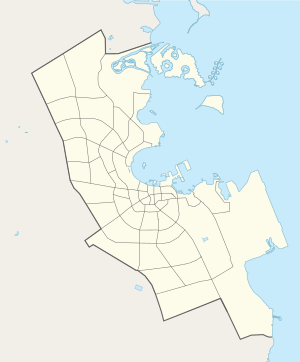 Al Bidda Al Bidda 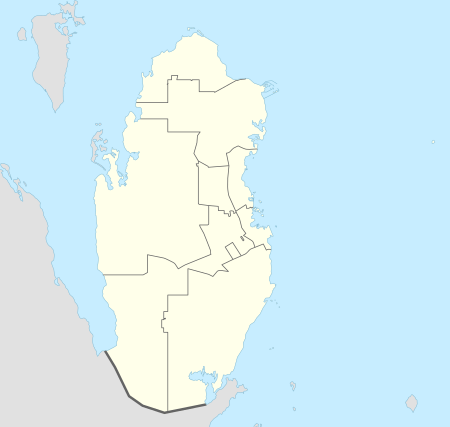 Al Bidda Al Bidda (Qatar) | |
| Coordinates: 25°17′59″N 51°31′11″E | |
| Country | |
| Municipality | Ad-Dawhah |
| Zone | Zone 2, Zone 12 |
| District no. | 2 |
| Area | |
| • Total | 1.3 km2 (0.5 sq mi) |
| Population | |
| • Total | 1,102 |
| • Density | 850/km2 (2,200/sq mi) |
| [1] | |
Qatar's Amiri Diwan (Presidential Office) has been based in Al Bidda since 1915, after being converted from an abandoned Ottoman fort.[2]
Etymology
Bidda is derived from the Arabic word badaa, meaning "to invent". When the previously uninhabited area first became populated, a settlement was essentially invented, giving it its name.[3]
History
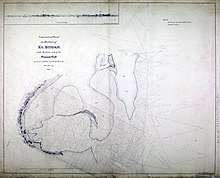
The earliest documented mention of Al Bidda was made in 1681, by the Carmelite Convent, in an account which chronicles several settlements in Qatar. In the record, the ruler and a fort in the confines of Al Bidda are alluded to.[4]
19th century
Al Bidda became the most important town in the country after the decline of Zubarah in the early nineteenth century. Doha, the present-day capital, developed from Al Bidda.[5] David Seaton, a British political resident in Muscat, detailed one of the earliest English accounts of Al Bidda in 1801:
Account by David Seaton: —
- Bedih [sic] is Situated in 25.18 N. Lat. and is a large open bay full of Coral banks with very unequal soundings from twelve to three fathoms, the land is low and sandy, hardly to be seen at the distance of ten Miles, on a nearer approach, it seems gradually rising from both extremes towards the centre, where it forms a ridge at the distance of half a Mile from the Shore, under this ridge near the sea, are two hillocks and a Valley between them, off each of the hillocks runs a Shoal with half a fathom at high water and between them a Channel with one and a half fathoms, and at the distance of a Mile and a half three fathoms, on the Northern hillock is a fortified House with a Wall and Square tower, in the Valley a breast Work with two Guns, and on the southern hillock two large huts with some kind of defence, and half a Mile to the Southward near the ridge is another Square building with a flag staff, under the Northern hillock is a sandy beach on which two Buglas, one Dow & one Botella were drawn up with a breast work of Stones, the only direct landing place is in the mouth of the Valley, but it would be attended with great loss without ships to drive the Enemy away as it is flanked by the breast work and boats, in which were a number of Men and ten Guns, and fronted by the two Guns in the Valley, about two Miles to the South is a Sandy beach without cover for the Enemy's snipers, but the Square building with the flagstaff must be stormed before the hillocks can be got at.[6]
In January 1823, political resident John MacLeod visited Al Bidda to meet with the ruler and initial founder of Doha, Buhur bin Jubrun, who was also the chief of the Al-Buainain tribe.[7][8] MacLeod noted that Al Bidda was the only substantial trading port in the peninsula during this time. Following the founding of Doha, written records often conflated Al Bidda and Doha due to the extremely close proximity of the two settlements.[7] Later that year, Lt. Guy and Lt. Brucks mapped and wrote a description of the two settlements. Despite being mapped as two separate entities, they were referred to under the collective name of Al Bidda in the written description.[9][10]
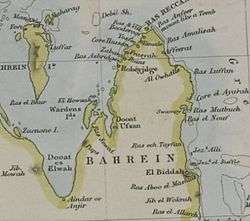
In 1847, Al Bidda was demolished by the sheikh of Bahrain and its inhabitants were removed to Bahrain.[11] The sheikh also placed economic blockade over the town in 1852.[12] In 1867, a large number of ships and troops were sent from Bahrain to punish the people of Al Wakrah and Al Bidda. Abu Dhabi joined on Bahrain's behalf due to the conception that Al Wakrah served as a refuge for fugitives from Oman. Later that year, the combined forces sacked the two aforementioned Qatari cities with 2,000 men in what would come to be known as the Qatari–Bahraini War.[13][14] A British record later stated "that the towns of Doha and Wakrah were, at the end of 1867 temporarily blotted out of existence, the houses being dismantled and the inhabitants deported".
Around early 1871, the town became a base of operations for Bedouins resisting Ottoman rule after they established a foothold in Eastern Arabia that year.[15] By December 1871, emir Jassim bin Mohammed authorized the Ottomans to send 100 troops and equipment to Al Bidda.[16] Shortly after, Qatar was assimilated as a province in the Ottoman Empire, and Al Bidda was recognized as the official provincial capital.[17]
Al Bidda Fort served as the final stronghold for Ottoman troops in the 1893 Battle of Al Wajbah. They surrendered after Jassim bin Mohammed's troops cut off the town's water supply and besieged the fortress.[18] An Ottoman report compiled the same year reported that Al Bidda and Doha had a combined population of 6,000 inhabitants, jointly referring to both towns by the name of 'Katar'. Al Bidda was classified as the western section of Katar, and was stated to have mainly accommodated members of the Al Kuwari and Soudan tribes.[19][17]
20th century
In J.G. Lorimer's Gazetteer of the Persian Gulf first published in 1908, he describes Al Bidda as a large town which is a natural harbor due to its reefs, but states that vessels of more than 15 feet draft cannot pass. The land is described as stony desert which is 40 or 50 feet above sea-level. The majority of its inhabitants, who were said to be involved in pearl fishing, were composed of Qatari tribes, such as the Al-Soudan, Bahraini shopkeepers and immigrants from Al-Hasa.[20]
Geography
Al Bidda borders the following districts:[3]
Landmarks
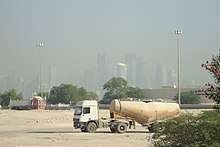
- Al Sheukh Mosque on Al Qasr Street.[3]
- Al Bidda Historical Tower on Umm Al Dome Street.[3]
- Al Bidda Fort on Jebel Soudan.[21]
- Al Bidda West Park on Al Rayyan Road.[3]
- Qatar Bowling Centre (under the auspices of Qatar Olympic Committee) on Al Qurtubi Street.[3]
- Amiri Diwan on Al Corniche Street.[3]
- Al Bidda Clock Tower on Al Corniche Street.[3]
- Al Bidda Park (formerly known as Rumaila Park) is partially located in Rumeilah on Al Corniche Street and is split into two parts by Rumeilah Street.[3]
Development
Al Bidda tower, a 215-metre tall building, is currently being constructed in the district. It is planned to accommodate 43 stories and will have an aggregate net rentable area of 41,500 m². The curtain wall features a whirlwind design. Facilities will include commercial space, business centers, art galleries, restaurants, and a health club.[22]
Transport
Major roads that run through the district are Qalat Al Askar Street, Jassim Bin Mohammed Street, Corniche Street and Al Rayyan Road.[23]
The underground Al Bidda station currently serves as an interchange station between the Red Line and the Green Line of the Doha Metro.[24] As part of the metro's Phase 1, the station was inaugurated on 10 December, 2019, along with all other Green Line stations.[25] It is located in Al Bidda Park on Al Rayyan Road.[26] The station is one of the Doha Metro's most vital stations as it provides connectivity between two of the Doha Metro's three existing lines.[27]
Among the station's facilities are an Ooredoo self-service machine, a prayer room and restrooms.[26] Nearby landmarks within walking distance include Al Bidda Park and the Qatar Bowling Centre.[27] There are no metrolinks for the station.[26]
Demographics
.jpg)
As of the 2010 census, the settlement comprised 91 housing units[28] and 6 establishments.[29] There were 1,102 people living in the settlement, of which 98% were male and 2% were female. Out of the 1,102 inhabitants, 99% were 20 years of age or older and 1% were under the age of 20.[30]
Employed persons made up 99% of the population. Females accounted for 1% of the working population, while males accounted for 99% of the working population.[30]
| Year | Population |
|---|---|
| 1986[31] | 4,436 |
| 1997[32] | 3,558 |
| 2004[33] | 1,379 |
| 2010[1] | 1,102 |
Gallery
References
- "2010 population census" (PDF). Qatar Statistics Authority. Archived from the original (PDF) on 2 April 2015. Retrieved 29 June 2015.
- "Searching for Historic Bidda: Ground Penetrating Radar Survey in Qatar". University College London. 31 March 2015. Retrieved 30 December 2018.
- "District map". The Centre for Geographic Information Systems of Qatar. Retrieved 30 December 2018.
- "Historical references to Doha and Bidda before 1850" (PDF). The Origins of Doha Project. p. 1. Retrieved 19 May 2015.
- Toth, Anthony. "Qatar: Historical Background." A Country Study: Qatar (Helen Chapin Metz, editor). Library of Congress Federal Research Division (January 1993). This article incorporates text from this source, which is in the public domain.
- Carter, Robert. "Origins of Doha Season 1 Archive Report". academia.edu. p. 11. Retrieved 13 March 2015.
- "Historical references to Doha and Bidda before 1850" (PDF). The Origins of Doha Project. p. 4. Retrieved 19 May 2015.
- Habibur Rahman, pg 63
- "Historical references to Doha and Bidda before 1850" (PDF). The Origins of Doha Project. p. 5. Retrieved 19 May 2015.
- Brucks, G.B. (1985). Memoir descriptive of the Navigation of the Gulf of Persia in R.H. Thomas (ed) Selections from the records of the Bombay Government No XXIV (1829). New York: Oleander press.
- Rahman, Habibur (2006). The Emergence Of Qatar. Routledge. p. 98. ISBN 978-0710312136.
- Habibur Rahman, pgs. 113–114
- "'A collection of treaties, engagements and sanads relating to India and neighbouring countries [...] Vol XI containing the treaties, & c., relating to Aden and the south western coast of Arabia, the Arab principalities in the Persian Gulf, Muscat (Oman), Baluchistan and the North-West Frontier Province' [113v] (235/822)". Qatar Digital Library. Retrieved 12 January 2015.
- "'File 19/243 IV Zubarah' [8r] (15/322)". Qatar Digital Library. Retrieved 12 January 2015.
- Habibur Rahman, pgs. 138–139
- Habibur Rahman, pg. 140
- Kurşun, Zekeriya (2002). The Ottomans in Qatar : a history of Anglo-Ottoman conflicts in the Persian Gulf. Istanbul : Isis Press. pp. 16–17. ISBN 9789754282139.
- Habibur Rahman, p. 152
- "Historical references to Doha and Bidda before 1850" (PDF). The Origins of Doha Project. p. 11. Retrieved 19 May 2015.
- "'Persian Gulf Gazetteer Part II, Geographical and Descriptive Materials, Section II Western Side of the Gulf' [49v] (101/286)". Qatar Digital Library. Retrieved 23 July 2015. This article incorporates text from this source, which is in the public domain.
- "Dalila Services". Ministry of Municipality and Environment. Retrieved 6 January 2019.
- "Al Bidda tower - Doha, Qatar". Bam International. Retrieved 13 March 2015.
- "Index map of Qatar". ArcGIS.com. Retrieved 25 August 2019.
- "QAR Metro". arcgis.com. Archived from the original on 4 December 2019. Retrieved 17 March 2019.
- "All Doha Metro lines open for public". The Peninsula. 10 December 2019. Retrieved 16 December 2019.
- "Plan My Journey Map". Qatar Rail. Retrieved 6 December 2019.
- "Places to visit near Doha Metro stations". iloveqatar.net. 27 November 2019. Retrieved 6 December 2019.
- "Housing units, by type of unit and zone (April 2010)" (PDF). Qatar Statistics Authority. Archived from the original (PDF) on 8 July 2015. Retrieved 7 August 2015.
- "Establishments by status of establishment and zone (April 2010)" (PDF). Qatar Statistics Authority. Archived from the original (PDF) on 8 July 2015. Retrieved 7 August 2015.
- "Geo Statistics Application". Ministry of Development Planning and Statistics. Archived from the original on 2012-09-11. Retrieved 7 August 2015.
- "1986 population census" (PDF). Qatar Statistics Authority. Archived from the original (PDF) on 3 July 2015. Retrieved 2 July 2015.
- "1997 population census" (PDF). Qatar Statistics Authority. Archived from the original (PDF) on 29 May 2015. Retrieved 2 July 2015.
- "2004 population census". Qatar Statistics Authority. Archived from the original on 24 September 2015. Retrieved 1 July 2015.
